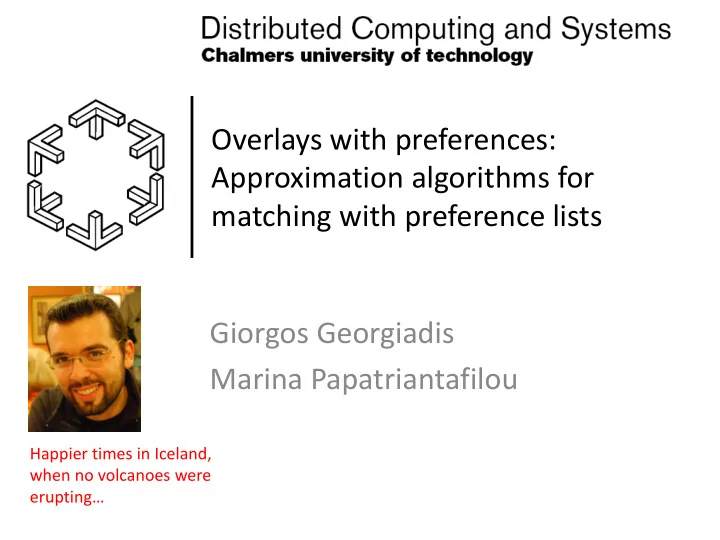

Overlays with preferences: Approximation algorithms for matching with preference lists Giorgos Georgiadis Marina Papatriantafilou Happier times in Iceland, when no volcanoes were erupting…
Overview • How do nodes flirt? • Matching with preferences • Recent work on matchings • Key question • Satisfaction and how it works • Distributed Matching using satisfaction • Calculating the approximation • Conclusions/Future work
How do nodes flirt*? Nodes may strive for the best <enter metric here> prefer “better” nodes/peers to connect to They use Node i wants to preferences chose the b i “best” when ones matching better worse Distance, Bandwidth Preference list Latency Social info, Connectivity trust, etc *Especially when they are polygamous
Matching with preferences Nodes are tough customers • Well studied (centralized) • More complex than simple matching [GaleShapley62, Iwama-etal99, Manlove-etal02, Irving-etal07, …] • Stability in focus of these studies Marriages Roommates Stable solution? Yes* Stable solution? Not always *no ties though
Recent work on matchings [Gai-etal07, Lebedev-etal07, Mathieu08]: • b-matching with preferences [aka stable fixtures, Irving-etal07]; stabilization in overlay construction 1. m-to-m matchings: proposal-refusal distributed algorithm leads to stable conf in n 2 initiatives 2. acyclic preferences imply stable configurations 3. If stable configuration exists, can be reached in a finite number of blocking pair resolutions Defined Satisfaction • ( ) ( ) max 1, subtract ( ) ( ) ( ) ( ) ( ) − − R C i c i 1 R C i 1 1 1 1 i c i = − + + − 1 i penalty for each S i b b L b b L i i i i i i “hole” in the list
Simulation results [Mathieu08] Satisfaction and convergence Problem Convergence time Satisfaction Instance i = B (best) i = R (random) i = H(hybrid) Mean Std Mean Std Mean Std Mean Std Global ordering 45.0 1.5 947.2 162.0 43.0 2.0 0.52 0.0 Random ordering N/A 0.77 0.031 • Random ordered lists could not converge (!) S = < • Globally ordered lists converge but 0.52 0.77
Key question What is important in m-to-m matchings? • Strict stabilization? • Some stabilization condition? • Something else?
Overview • How do nodes flirt? • Matching with preferences • Recent work on matchings • Key question • Satisfaction and how it works • Distributed Matching using satisfaction • Calculating the approximation • Conclusions/Future work
How satisfaction works Preference list Connection list ( = + + ) 1 st 2 nd 3 rd connection ( ) ( ) − R j Q j 1 ∑ = − i i S i b b L ∈ j C i i i i
Classical stable matchings revisited An example Stable matching + Satisfaction = Optimization problem
Approximating satisfaction Static + Dynamic term Only static term ( ) ( ) ( ) − R j Q j R j 1 1 ∆ = − ∆ = − j i i j i S S i i b b L b b L i i i i i i
The story so far… … and then some. Satisfaction maximization problem Approx satisfaction maximization problem • Satisfaction values are known locally from the beginning • Neighbors exchange and add (approx) satisfaction values • Weights for edges are formed Maximum m2m weighted matching • Non-trivial to solve!
Greedy Local Distributed Matching (LID algo) using satisfaction iDo! Greedy Distributed m2m weighted Matching • p i : find b i locally heaviest edges • Generalization of 1-1 weighted matching by [Hoepman04] • Convergence depends on longest weight chains Lemma: LID algo gives ½ approximation of opt weighted many-to-many matching Generalization of proof in [Preis99] for centralized 1-1 matching 1 1 - approximation of optimal max satisfaction + Thm: ... 1 4 b max
Distributed Matching using satisfaction Initialization phase Calculate & Send Create new list ∆ ∆ * * S S A B ∆ * S D ∆ * S C
Distributed Matching using satisfaction Matching phase Send PROP to top b i Upon REJ continue 1 1 + -approximation of optimal Total satisfaction (sum): 3.0 1 4 b max
Calculating the approximation Two steps to 1 1 + 1 4 b max ∆ ∆ 1. Using approx. satisfaction instead of S S 1 1 + 1 2 b max 2. Fully distributed many-to-many matching algorithm 1 2
Calculating the approximation 1 Using approx. satisfaction static dynamic • Find the proportions of and inside S S i i ( ) ( ) − R j Q j 1 ∑ = − i i S i b b L ∈ j C i i i i dynamic static Hint: max when b i connections and lowest when S S i i these connections are from the bottom of the list. static S 1 1 ≥ + • Deduce: i 1 + static dynamic S S 2 b max i i
Conclusion How to keep everybody (approx) happy*? Overlay construction and matching • Seeking alternative to classical stable matchings: satisfaction • Converted max satisfaction problem to m-to-m weighted • matching Distributed m-to-m weighted matching algorithm ( LID ) • – Guaranteed minimum collective satisfaction – Exchange of local info only (cf. also “price of being near-sighted” [Kuhn-etal06]) Algorithm of independent interest to weighted matchings • *provided they cooperate
Future work And now? Other optimization targets may be set (ie min individual • satisfaction). Could it work to build on more sophisticated matching algos? • (can get better approx.ratio/convergence?) Relation of convergence and churn? • Non-collaborating actions/nodes? •
Thank you for your attention! Contact {georgiog,ptrianta}@chalmers.se Visit http://www.cs.chalmers.se/~dcs/
Recommend
More recommend